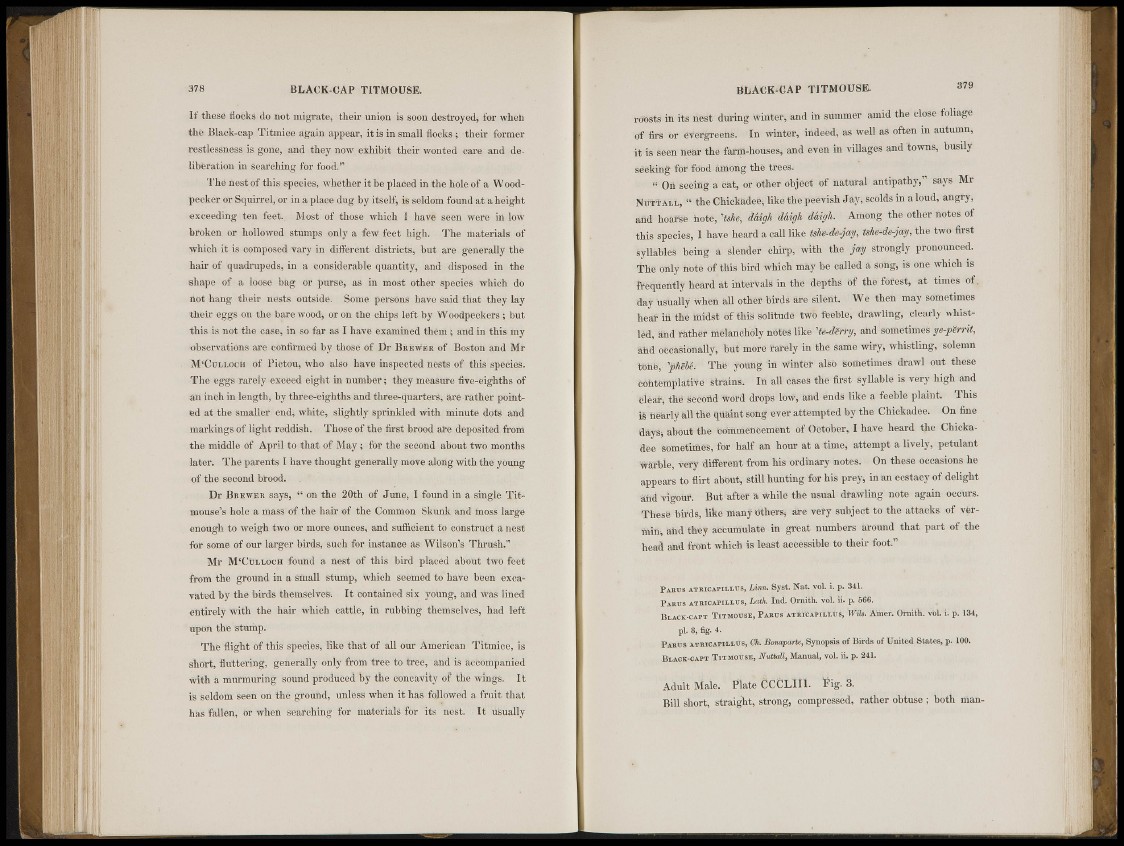
378 BLACK-CAP TITMOUSE.
If thesé flo6ks do not migrate, their union is soon destroyed* for wheh
the Black-cap Titmice again appear, it is in small flocks i their former
restlessness is gone, and they now exhibit their wonted care audi, deliberation
in searching for food."
The nest of this species, whether it be pl&éed-in the hole of a Woodpecker
or Squirrel, or in a place dug by itself, it seldom found at a height
«Meeding ten feet. Most of those which I h aye seen were in low
broken or hollowed stumps only a few (cot high. The materials Of
which it is composed Vary in diflferent districts, but are generally the
hair of quadrupeds, in a considerable quantity, and disposed in the
Shape Of a loose bag or purse, as in most Other species which do
not hang their nests outside: Some persons have said that they lay
their eggs on the bare wotxl^ or on the chipá left by Woodpeckers:;;, but
this is. not the case, in so far as I have examined them ; and in this fny
observations are confirmed by tboSd of Ü R BRKWER of Boston and Mr
M ' C Ü I Í L O C H of Pictou, Who also have, inspected nests of this species.
The eggs rarely exceed eight in number; they measure five-eighths of
ail indh in length, by three-eighths arid threé-quárters, tire rather pointed
at the smaller end, white, slightly sprinkled With minute dots and
markings of light reddish. Thosefflf the first brood at® deposited from
tho middle of April to that of May î fat the second about two months
later. The parent* I have thought generally move along with the young
of the second brood,
Dr B R EWE R says, " on the 20th of June, I fourni in a single Titmouse's
hole a mass of the hair of the Common Skunk and moss large
enough to weigh two or more ounces,, and sufficient to construct a nest
for some of our larger birds, Such for instance às Wilson's Thrush,"
Mr M'CÎ ÎLLOCH 'found a nost of this bird placed about two feet
from the ground in a small stiimp, which seemed to have been t.'Xcavjitvd
by the birds themselves It contained sis young, and was lined
entirely with the hair which cattle, in rubbing tkemselves, had left
upon the stump.
The flight Of this »peines, like that of fell our American Titmice, ;ls
start, fluttering, generally only from tree to tree, and is accompanied
with a murmuring sotind produced by the concavity of the wings. It
is SeMóift seen on the ground, unless when it has followed a fruit that
has ïallën, or When searching foï materials for Its nest. It usually
BliACK-CAP TITMOUSE. 379
rewsts in its nest during winter, and in summer amid the close foliage
Of firs Or evergreens. In winter, Meed, as well as often in autumn,
it fe Sees Meet the farffl-hoflses4 and even in villages and towns, busily
srieking fM fdod among "thè trees.
" Oft sceifig a gat, or other object of natural antipathy," says Mr
mtWAti, " the eSickftdeS-, like the peevish Jay, Scolds in a loud, angry,
afld boat's* hote, "fsfo, dAigk dàigh. Migli. Among the other notes of
this species, 1 have heard a call like tsto^ay, tihe>de-jay, the two first
syllaTM'-beat'^ Slender chirp, with thè jM/ strongly pronounced.
Tilts only hole of this bird whieTi may be''.Milled a song, is one which is
frequently heard at interval» in the depths of the forest, at times of.
day usually \vh(!n all other birds are sileftt. We theft may sometimes
heaf' iti the iffidàt 6f this sOlitùdë twî> ftieblc, drawling, clearly whistled,
atid Wither mfclani'lióìy niWf'S like 'te-dtri-y, an.) sotmStimos ye-pfrrit,
ahd otiwBioHally, 'bùt moré Mróly ili the same wiry, whistling, solemn
tttfty 'phëM. The yoticfig "ifl «uftttif also sometimes drawl out these
còhtoitii.lath'e strains. IS all i e s ffië'fiM syllabi* is very high and
filêai, tltó Hécóftd word drôpS 1W, and ends like a feeble plaint. This
IS flëSïly fill thè p a i n t SMig ever attempted by the Chickadee, On fine
dayss about the i'ommeiiconittit of Octobor, I have heard the Chickadee
sometimes, fbï half aft hour at a time, attempt a lively, petulant
Wffibìe, veiy different from Ms ordinary notes.- On these occasions he
appears to flirt abeti«, still hunting for his prey* in an ecStacy of delight
jffld vîfoflï. But after a While thé usual drawling note again occurs.
B H M like many tìthers, are very subject to the attacks of vèr-
®iin-, «ftd t t ey accumulate in great numbers atound that part, of the
head afcA front which is least accessible to their foot "
PARUS ATRt<:AI'n.I.T:s, Unit. $YST. N a t , vol i. P . 341.
PARUS ATRIOAILLLLTS„IOTI. till!. (Irnitll. T A « ^ 566.
BLACK-CAM T u m u l a , PARUS ATRICAFÏIXUS, Wiîs. Àiher . Otnl t l i . vbl. i. p . 134,
pl. S, fig. 4.
P.ARtTB ATRICAPI-Liius, C%. Jiowqxirte, Synapsis of Birds of United States, p. 100.
BLACK-CAPT TITMOUSE, Nuttall, Manual, vol. ii. p. 241.
Adult Male. Piate é cÊLÏ t l . ¥ig. 3.
Bill short, straight, strong, compressed, rather obtuse ; both man